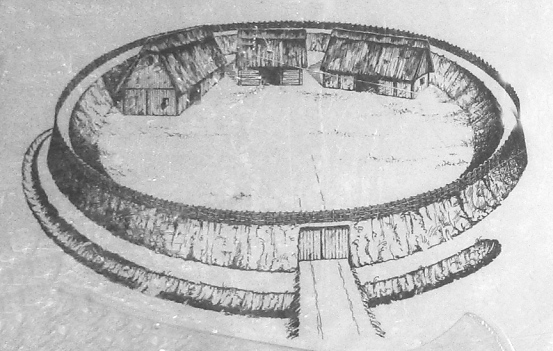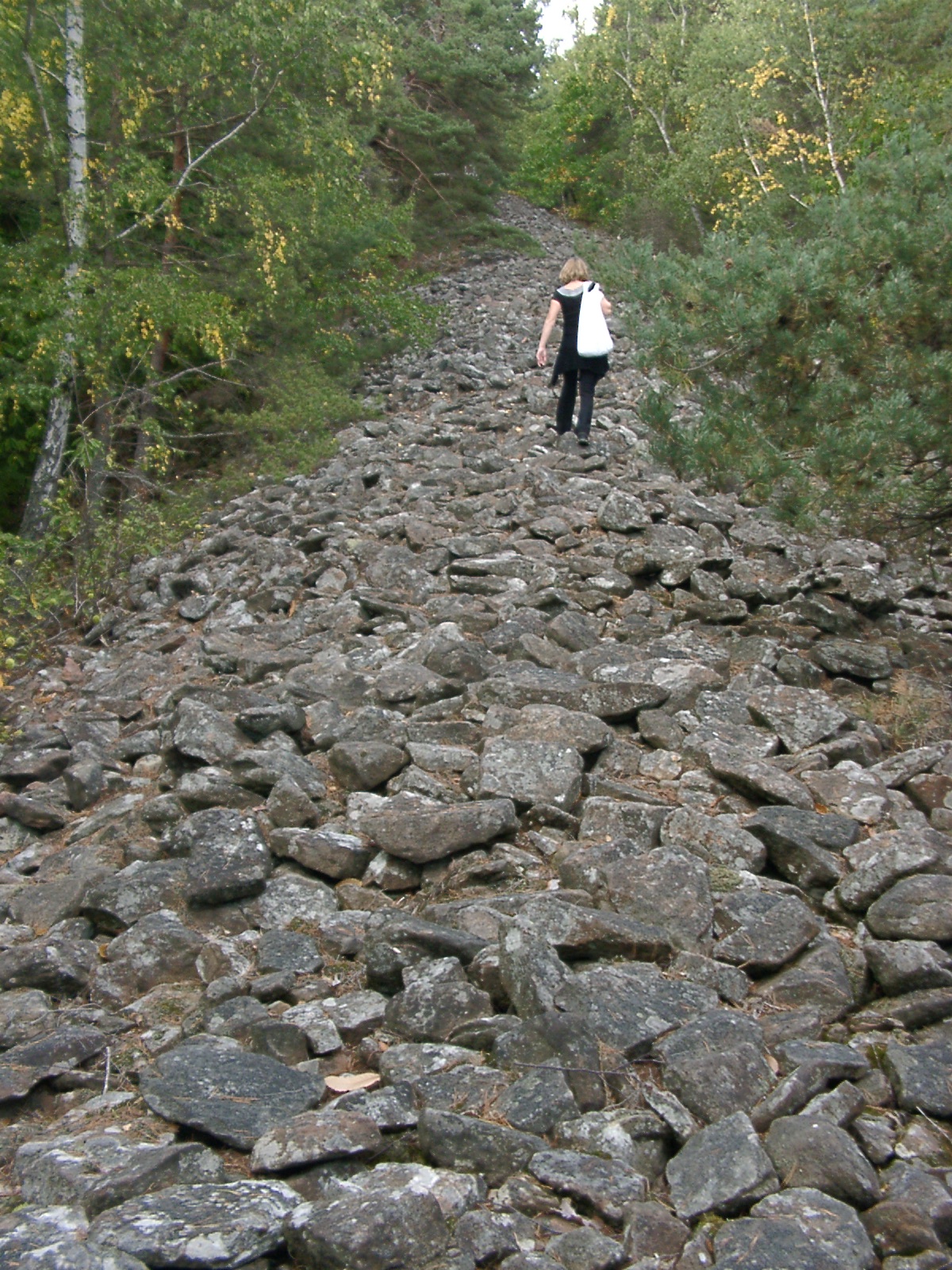circular rampart on:
[Wikipedia]
[Google]
[Amazon]
 A circular rampart () is an embankment built in the shape of a
A circular rampart () is an embankment built in the shape of a
 The key feature of a circular
The key feature of a circular

 Circular ramparts are found in north and western Europe, for example, in
Circular ramparts are found in north and western Europe, for example, in
 * Aggersborg, near Aggersund, Denmark
* Circular rampart of Burg, near
* Aggersborg, near Aggersund, Denmark
* Circular rampart of Burg, near
"Die Burgwälle Ostthüringens"
in ''Die Fundpflege''. Yr 3, Issue 2/3 (June 1935), pp. 9–15. * Orser, Charles E., ''Encyclopedia of historical archaeology'', Routledge, 11 April 2002,
Old Basing, Hampshire, England
{{DEFAULTSORT:Circular Rampart Archaeological sites Fortifications by type Stone Age Medieval defences
 A circular rampart () is an embankment built in the shape of a
A circular rampart () is an embankment built in the shape of a circle
A circle is a shape consisting of all point (geometry), points in a plane (mathematics), plane that are at a given distance from a given point, the Centre (geometry), centre. The distance between any point of the circle and the centre is cal ...
that was used as part of the defences for a military fortification, hill fort
A hillfort is a type of fortification, fortified refuge or defended settlement located to exploit a rise in elevation for defensive advantage. They are typical of the late Bronze Age Europe, European Bronze Age and Iron Age Europe, Iron Age. So ...
or refuge, or was built for religious purposes or as a place of gathering.
The period during which these structures were built ranged from the Neolithic
The Neolithic or New Stone Age (from Ancient Greek, Greek 'new' and 'stone') is an archaeological period, the final division of the Stone Age in Mesopotamia, Asia, Europe and Africa (c. 10,000 BCE to c. 2,000 BCE). It saw the Neolithic Revo ...
to the Middle Ages
In the history of Europe, the Middle Ages or medieval period lasted approximately from the 5th to the late 15th centuries, similarly to the post-classical period of global history. It began with the fall of the Western Roman Empire and ...
.
Construction
 The key feature of a circular
The key feature of a circular rampart
Rampart may refer to:
* Rampart (fortification), a defensive wall or bank around a castle, fort or settlement
Rampart may also refer to:
* LAPD Rampart Division, a division of the Los Angeles Police Department
** Rampart scandal, a blanket ter ...
is that the embankment formed the primary element of the defensive fortification.Radig (1935), pp. 9–10. It can be constructed in various ways: as a simple earth embankment, as a wood and earth structure, or as a wall. Circular ramparts usually have a moat
A moat is a deep, broad ditch dug around a castle, fortification, building, or town, historically to provide it with a preliminary line of defence. Moats can be dry or filled with water. In some places, moats evolved into more extensive water d ...
or ditch
A ditch is a small to moderate trench created to channel water. A ditch can be used for drainage, to drain water from low-lying areas, alongside roadways or fields, or to channel water from a more distant source for plant irrigation. Ditches ...
in front of them; the embankment can be enhanced with a wooden palisade
A palisade, sometimes called a stakewall or a paling, is typically a row of closely placed, high vertical standing tree trunks or wooden or iron stakes used as a fence for enclosure or as a defensive wall. Palisades can form a stockade.
Etymo ...
. They are mostly found on lowlands, but sometimes encircle the summit of a hill. Often several concentric rings were built, which produced a more effective defensive position against attackers. The interior of such sites often shows evidence of buildings such as halls, barns, and other secondary structures.
Locations

 Circular ramparts are found in north and western Europe, for example, in
Circular ramparts are found in north and western Europe, for example, in Denmark
Denmark is a Nordic countries, Nordic country in Northern Europe. It is the metropole and most populous constituent of the Kingdom of Denmark,, . also known as the Danish Realm, a constitutionally unitary state that includes the Autonomous a ...
, Estonia
Estonia, officially the Republic of Estonia, is a country in Northern Europe. It is bordered to the north by the Gulf of Finland across from Finland, to the west by the Baltic Sea across from Sweden, to the south by Latvia, and to the east by Ru ...
, Sweden
Sweden, formally the Kingdom of Sweden, is a Nordic countries, Nordic country located on the Scandinavian Peninsula in Northern Europe. It borders Norway to the west and north, and Finland to the east. At , Sweden is the largest Nordic count ...
, Germany
Germany, officially the Federal Republic of Germany, is a country in Central Europe. It lies between the Baltic Sea and the North Sea to the north and the Alps to the south. Its sixteen States of Germany, constituent states have a total popu ...
, Great Britain
Great Britain is an island in the North Atlantic Ocean off the north-west coast of continental Europe, consisting of the countries England, Scotland, and Wales. With an area of , it is the largest of the British Isles, the List of European ...
, Belgium and the Netherlands; in central Europe, in Austria
Austria, formally the Republic of Austria, is a landlocked country in Central Europe, lying in the Eastern Alps. It is a federation of nine Federal states of Austria, states, of which the capital Vienna is the List of largest cities in Aust ...
and Switzerland
Switzerland, officially the Swiss Confederation, is a landlocked country located in west-central Europe. It is bordered by Italy to the south, France to the west, Germany to the north, and Austria and Liechtenstein to the east. Switzerland ...
; in southeastern Europe in Romania
Romania is a country located at the crossroads of Central Europe, Central, Eastern Europe, Eastern and Southeast Europe. It borders Ukraine to the north and east, Hungary to the west, Serbia to the southwest, Bulgaria to the south, Moldova to ...
, Moldova
Moldova, officially the Republic of Moldova, is a Landlocked country, landlocked country in Eastern Europe, with an area of and population of 2.42 million. Moldova is bordered by Romania to the west and Ukraine to the north, east, and south. ...
and Ukraine
Ukraine is a country in Eastern Europe. It is the List of European countries by area, second-largest country in Europe after Russia, which Russia–Ukraine border, borders it to the east and northeast. Ukraine also borders Belarus to the nor ...
; and also in the United States
The United States of America (USA), also known as the United States (U.S.) or America, is a country primarily located in North America. It is a federal republic of 50 U.S. state, states and a federal capital district, Washington, D.C. The 48 ...
.Shoemaker, Nancy, ''American Indians'', WileyBlackwell, 1 October 2000, They are often hidden in woods and discovered by aerial photography. Archaeological profiles through the defences and excavations of the interior enable analysis of the period the site was occupied, the pottery used and the type of food consumed.
Notable circular ramparts
Celle
Celle () is a town and capital of the district of Celle (district), Celle in Lower Saxony, in north-central Germany. The town is situated on the banks of the river Aller (Germany), Aller, a tributary of the Weser, and has a population of about ...
, Lower Saxony
Lower Saxony is a States of Germany, German state (') in Northern Germany, northwestern Germany. It is the second-largest state by land area, with , and fourth-largest in population (8 million in 2021) among the 16 ' of the Germany, Federal Re ...
, Germany
* The Donnersberg
The Donnersberg (; literally: "thunder mountain") is the highest peak of the Palatinate () region of Germany. The mountain lies between the towns of Rockenhausen and Kirchheimbolanden, in the Donnersbergkreis district, which is named after th ...
, near Rockenhausen, Rhineland-Palatinate
Rhineland-Palatinate ( , ; ; ; ) is a western state of Germany. It covers and has about 4.05 million residents. It is the ninth largest and sixth most populous of the sixteen states. Mainz is the capital and largest city. Other cities are ...
, Germany
* Castle Dore, Cornwall, England
* Fyrkat, Denmark
* Gråborg, built in stages between years 500–1100, Öland
Öland (, ; ; sometimes written ''Oland'' internationally) is the second-largest Swedish island and the smallest of the traditional provinces of Sweden. Öland has an area of and is located in the Baltic Sea just off the coast of Småland. ...
, Sweden
* The Heidenmauer near Bad Dürkheim
Bad Dürkheim () is a spa town in the Rhine-Neckar urban agglomeration. It is the seat of the Bad Dürkheim (district), Bad Dürkheim district in Rhineland-Palatinate, Germany, and the site of the discovery of the element caesium, in 1860.
Geogra ...
, Germany
* Nanih Waiya, a Choctaw mound, Winston County, USA
* The circular rampart at Old Basing
Old Basing is a village in Hampshire, England, just east of Basingstoke. It was called ''Basengum'' in the Anglo-Saxon Chronicle and ''Basinges'' in the Domesday Book.
Etymology
The name Basing comes from two Old English components: ''Basa'', t ...
, Hampshire, England
* Celtic circular wall of Otzenhausen, Saarland
Saarland (, ; ) is a state of Germany in the southwest of the country. With an area of and population of 990,509 in 2018, it is the smallest German state in area apart from the city-states of Berlin, Bremen, and Hamburg, and the smallest in ...
, Germany
* Saxon rampart on the Marienberg near Nordstemmen, Germany
* Varbola Stronghold largest circular rampart fortress built in Estonia
Estonia, officially the Republic of Estonia, is a country in Northern Europe. It is bordered to the north by the Gulf of Finland across from Finland, to the west by the Baltic Sea across from Sweden, to the south by Latvia, and to the east by Ru ...
(10th – 12th century)
* Viking ring fortress
A Viking ring fortress, Trelleborg-type fortress, or trelleborg (pl. ''trelleborgs''), is a type of circular fort of a special design, built in Scandinavia during the Viking Age. These fortresses have a strictly circular shape, with roads and g ...
of Trelleborg
Trelleborg () is a town in Skåne County, Sweden, with 43,359 inhabitants as of 31 December 2015. It is the southernmost town in Sweden located some west from the Smygehuk, southernmost point of Sweden and the Scandinavian Peninsula. It is one ...
, Sweden
See also
* * *References
Literature
* Radig, Dr. Werner (1935)"Die Burgwälle Ostthüringens"
in ''Die Fundpflege''. Yr 3, Issue 2/3 (June 1935), pp. 9–15. * Orser, Charles E., ''Encyclopedia of historical archaeology'', Routledge, 11 April 2002,
External links
Old Basing, Hampshire, England
{{DEFAULTSORT:Circular Rampart Archaeological sites Fortifications by type Stone Age Medieval defences